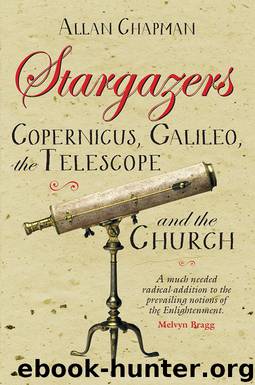Stargazers by Allan Chapman

Author:Allan Chapman [Chapman, Allan]
Language: eng
Format: epub
Publisher: Lion Books
Published: 2014-10-16T23:00:00+00:00
16.2 Pierre Gassendi’s “Astronomical Radius”. The Astronomical Radius was a popular instrument in Renaissance Europe. It worked on similar geometrical principles to “Ptolemy’s Rulers” (Figure 3.1). The long rod acts as the radius to a circle, and the shorter “T” rod as a tangent to the same circle. Gassendi and an assistant would have measured the angle subtended between a pair of astronomical bodies by sliding brass sights along the tangent rod, as viewed against a fixed brass sight set at the end of the long rod. The graduation spaces between the sliding sights of the short, tangent, rod would then have been calculated against the known, fixed length of the long rod. In this way, the geometry of complementary right-angled triangles could be used to derive the number of degrees and minutes of arc between the objects in the sky. (Reconstructed from Gassendi’s description by Allan Chapman.)
The first of these was his 1619 radius astronomicus, of 7 Paris feet (2,273 mm): a configuration of two beechwood beams jointed to form a “T” shape. Along the short arm of the T was a set of delicately subdivided graduations, which, when used in conjunction with three brass sights, could be employed to measure horizontal angles in the sky, such as between the moon and a planet. I reconstructed, made, and graduated this instrument in Oxford, then despatched it to France.
The second instrument was Father Gassendi’s 5 Parisian feet (1,624 mm) wooden astronomical quadrant. Because of its large size, instead of building the instrument in Oxford, I produced a set of full-sized, highly detailed engineering drawings, from which a French craftsman could then build it. Like the prototype, I gave it a full set of accurate Tycho Brahe degree graduations, which the Digne craftsmen could copy directly on to the brass scale.
With this instrument, Gassendi could measure vertical angles of celestial objects, and when it was used in conjunction with the radius, he could map the constellations – just as Tycho Brahe had done.
Download
This site does not store any files on its server. We only index and link to content provided by other sites. Please contact the content providers to delete copyright contents if any and email us, we'll remove relevant links or contents immediately.
| Buddhism | Christianity |
| Ethnic & Tribal | General |
| Hinduism | Islam |
| Judaism | New Age, Mythology & Occult |
| Religion, Politics & State |
Cecilia; Or, Memoirs of an Heiress — Volume 1 by Fanny Burney(32491)
Cecilia; Or, Memoirs of an Heiress — Volume 2 by Fanny Burney(31909)
Cecilia; Or, Memoirs of an Heiress — Volume 3 by Fanny Burney(31887)
The Secret History by Donna Tartt(18936)
Sapiens: A Brief History of Humankind by Yuval Noah Harari(14311)
Leonardo da Vinci by Walter Isaacson(13231)
The Radium Girls by Kate Moore(11965)
Sapiens by Yuval Noah Harari(5321)
How Democracies Die by Steven Levitsky & Daniel Ziblatt(5168)
The Wind in My Hair by Masih Alinejad(5055)
Homo Deus: A Brief History of Tomorrow by Yuval Noah Harari(4870)
Endurance: Shackleton's Incredible Voyage by Alfred Lansing(4715)
Man's Search for Meaning by Viktor Frankl(4495)
The Silk Roads by Peter Frankopan(4487)
Millionaire: The Philanderer, Gambler, and Duelist Who Invented Modern Finance by Janet Gleeson(4417)
The Rape of Nanking by Iris Chang(4165)
Joan of Arc by Mary Gordon(4051)
The Motorcycle Diaries by Ernesto Che Guevara(4046)
Hitler in Los Angeles by Steven J. Ross(3922)
